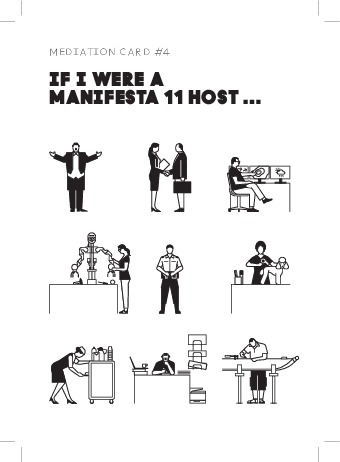
Mediation cards are available at the ticketing booth of Manifesta 11’s main venue (Migros Museum) in German, French and English. Put them in your pocket if you fancy a different approach on how to visit an art exhibition. With questions such as “Does your job have an influence on the way you look at things?” or “Does the artwork inspire any personal memories?”, advice such as how to wake up your body and mind within the exhibition space, and suggestions to compare the artworks in the historical exhibition, the mediation cards create a new kind of dialogue with the exhibits and challenge your relationship with art in general. From the immersion in Jon Rafman’s worrisome world to the vision of Jorinde Voigt’s Stress and Freedom journey, they have been developed to carry your reflections further.
My idea was to obtain some fresh, spontaneous feedback on the use of this mediation accessory from visitors at both Migros Museum and Kunsthalle to test how satisfied they were with it. As I talked to a man and his daughter, the girl quickly started drawing her dream profession on the card I had selected for her (brightly specifying that it was in fact her non-dream profession) while her father shared with me his various impressions – with as much transparency as possible, it must be said. According to him, the questions are good, but not well phrased nor addressed to anyone other than an imaginary visitor. His other criticism concerned the impracticality of the cards while moving within a room or standing right in front of a piece. How could they be integrated properly in a tour when discussing with friends or needing a tête-à-tête with a particular artwork? Fair question. As it turned out, my random approach was cursed by bad luck since this visitor revealed a personnal involvement in the topic as a professor for a Masters course in contemporary art mediation (MAC) in Paris, so harsh criticism was to be expected. After discussing the content of our cards for ten minutes or so, he said he also regretted that none of the cards deal with one artwork in particular. Why not concentrate on the reception of one specific joint venture or discuss one issue representative of the concept of Manifesta 11?
In the same venue, but adopting a different strategy, I asked the participants of my English-language open tour on Thursdays to freely express their opinions about the same cards package. Since these open-tours are not aimed at art professionals, but at visitors who are curious about contemporary art, this mediation package should be received more enthusiastically. Indeed, already very happy about the discussion form of the whole tour, they were also tempted to take some more questions back home to stimulate discussions around the dinner table. The cards seem to lend themselves especially well for cosy conversations like that but are less than ideal for use within the exhibition space, whether one is convinced by a particular piece or not. The human brain needs to have a rest to digest what the eyes have previously registered. But still, there is always an exception to the rule. What if you decided to be this exception? Come on, take five minutes of your time to put yourself in the shoes of a Manifesta 11 host at schwarzescafé. It’s definitely worth it!
Aurélie Pittori






